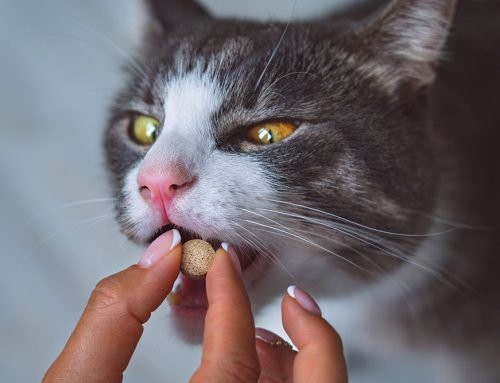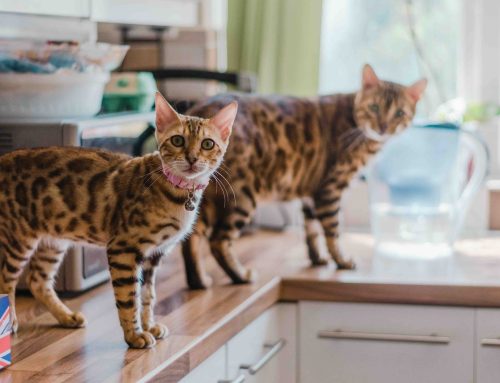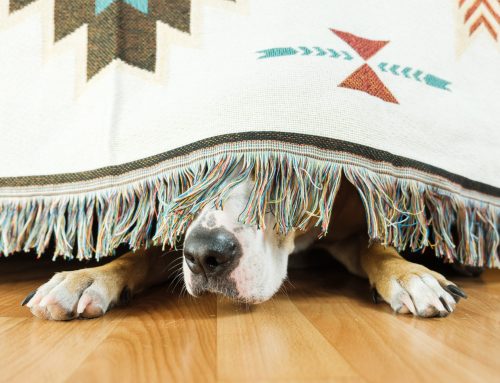“Oh, great,” you think to yourself. “Cheddar has peed on my bed. Again.” Thinking your cat is annoyed because you’ve been working so much lately, you try to give him extra love and attention, but he hisses when you run a hand along his spine. Worried about your feline friend, you schedule an appointment with Dr. Bahou at Alisos Animal Hospital.
At Cheddar’s appointment, Dr. Bahou and his team perform a physical exam and run a urinalysis on the uncomfortable cat. The test shows Cheddar has a thickened urinary bladder wall and a substantial amount of blood with the absence of bacteria in their urine, and Dr. Bahou determines Cheddar has developed feline idiopathic cystitis (FIC). This condition is a common cause of inappropriate elimination in otherwise healthy young adult cats, and requires lifelong management to prevent flare-ups.
Urinating outside the litter box is one of the most common complaints cat owners have about their feline housemates, and numerous causes could be behind this frustrating behavior. If your cat pees outside the litter box, here are five possible reasons why.
#1: Feline idiopathic cystitis (FIC)
Feline idiopathic cystitis has no established cause, but several theories exist. Cats with FIC might have a defective bladder lining, a neurogenic inflammation within their bladder, or abnormal stress responses. Most commonly, FIC will flare up during times of stress or anxiety. Signs of FIC can include bloody urine, inappropriate urination, pain when urinating, and small, frequent urination. Although these signs are similar to those of a urinary tract infection, they are not caused by a bacterial infection. A urinalysis and urine culture will find minimal bacteria, but an abnormal number of red and white blood cells, indicating inflammation. To manage FIC in your cat, try stress-relieving measures such as providing environmental enrichment with scratching posts, climbing towers, and interactive play to help reduce stress. Increasing water intake, maintaining a set routine, preventing bullying among your cats, and promoting a calm environment can also help manage FIC.
#2: Urinary tract infection (UTI)
Unlike FIC, which is seen in young adult cats, urinary tract infections are more commonly seen in older cats, especially those who have a pre-existing medical condition. Bacteria, white blood cells, and even urinary crystals can be present in the urine of a cat suffering from a UTI. Antibiotics can clear up an uncomplicated infection, but other therapies may be needed if the UTI is compounded by another medical issue.
#3: Chronic medical conditions
Cats with certain chronic medical conditions can be predisposed to developing urinary tract infections, or urinating outside the litter box. For example, diabetic cats are prone to urinating outside the litter box, especially if their disease is unregulated. As excess glucose leads to excessive thirst and urination, a diabetic cat may be unable to make it to the litter box each time. The same is true for cats with chronic kidney disease. When the kidneys fail to function properly and are unable to concentrate urine, the cat may inappropriately urinate. Management of chronic conditions can help reduce inappropriate elimination.
#4: Poor litter box hygiene
Nobody wants to use a dirty bathroom, especially your cat. If their litter box is unclean, or even has a different litter type, your cat may refuse to use it and find a quiet corner or soft surface. To keep your cat happy, scoop the litter box at least twice daily, and fully disinfect and replace the litter weekly. Most cats prefer fine, unscented litter, rather than heavily perfumed options. So, if your cat is peeing outside their box, double-check the cleanliness and litter type.
Another way to help keep your cat’s litter box clean is to ensure you have enough boxes for all the cats in your household. A good rule of thumb is to have one box per cat, plus an extra one. So, three cats should have at least four litter boxes, and the boxes should be placed in different areas of your home.
#5: Improper litter box placement

A poorly placed litter box could keep your cat from using it. If the box is in a high-traffic area or next to noisy household appliances, your cat may seek a quieter location. Or, if you have a feline bully in your household, your cat may feel threatened when trying to use the litter box if it’s in an out-of-the-way corner, especially if it’s covered. You should place one litter box on each floor, in quiet areas, and away from food and water dishes.
If your cat is urinating outside the litter box, it could quickly lead to an emergency situation. Contact our Alisos Animal Hospital team to schedule an appointment as soon as possible.








Leave A Comment